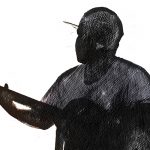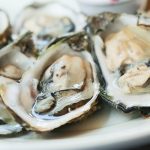Beneath the fingers of jazz impresario James Jarvis, the keys of any piano produce magic
By John Wolfe • Photograph by Mark Steelman
Hunched on a worn bench he sits, his face low and focused over ivory and ebony. Cascading up and down the keyboard, his hands give life to notes that form music which sometimes sounds like baby birds . . . sometimes like water gurgling over rocks in a mountain stream . . . sometimes like the turning of the seasons, autumn into winter and winter into spring.
It’s Wednesday evening at the Blind Elephant speakeasy in downtown Wilmington, and under a giant painted mural of a pachyderm, James Jarvis, jazz pianist and composer, is doing what he does best. The soundscapes he creates add layers of texture and atmosphere to the patrons’ convivial, cocktail-fueled conversation. He is the mood-maker for the evening. The people at the bar go on talking, but you can tell they are listening by the subconscious foot-taps, the pockets of applause between pieces. Jarvis has a way of creating musical moments that reach out and grab you by the heart; you can’t help but pause and admire what he’s doing. It’s almost like his piano is joining your own conversation. But not quite — his notes transcend spoken words, somehow, offering connection in a channel of communication rarely used. And no matter how many times you may hear him, he’s always pushing to say something new, pushing for a feeling unfelt until right now. His fingers play the whole instrument — his whole self — the whole world.
***
James Jarvis was raised in Ohio, that most American of states. Northeast Ohio, to be precise. Cleveland. Kent. In that land of the long winter, there is little else to do between October and May but stay indoors and get really, really good at something; in James’s case, it was music. He brought that focus and experience with him when he moved to Wilmington in 2004. For a decade he worked at the now-closed Piano and Organ Distributors on Market Street (whose awning was a black-and-white keyboard pattern). Pianos, which had long been his passion, became his trade. “It was like working at the dog pound,” he remembers. “I wanted to take every cute dog home with me.”
Many well-crafted instruments passed beneath that awning (as well as many “beautiful pieces of furniture,” the industry term for a piano with a high-gloss finish that has very little going on inside, instrument-wise). A handful moved Jarvis enough that he purchased them for himself; these are the instruments now scattered around town at the spots where he regularly plays.
Take Estelle, for instance. A sleek black Yamaha P-1 upright, born in 1960, she lives in an alcove down the text-lined corridor of Old Books on Front Street under a painting of a happy farmer. Jarvis plays here every Sunday afternoon from 3 until 5 p.m. (and on Saturdays, he gives lessons here). He bought this piano because “it was in a time warp” — i.e., in very good condition — given that it was built half a world away in the year Kennedy was elected president. For a while it lived at the Harp, then at the Calico Room before ending up at Old Books. Now Estelle is a “public art experience,” as denoted by a little faded paper placard, which means that anyone has permission to sit down and play her (just don’t set your drink on top, please).
It’s almost as if Estelle has absorbed pieces of the places she has been, and of the people who have played her over the years. She shows her past through the grooves and scars of her weathered patina. Pianos, almost more than any other instrument, have a way of making their histories tangible. Jarvis tells me of another piano he had for a while, a gorgeous 1900 Henry F. Miller grand, built in Boston: 900 pounds of cherry wood and cast iron, with legs carved in the French Provincial style. It would have originally been delivered from the factory by a horse and buggy. “When you play that instrument, you’re playing Teddy Roosevelt,” he says.
As we sit and admire Estelle, Jarvis tells me he knew from his time playing Steinways at Hiram College in his 20s that he wasn’t cut out for the “assembly line of academia” or the cutthroat world of competitive classical performance, the two most established avenues for pianists. “I didn’t care what people had done,” he says, his hand resting lightly on middle C, “I was in the now. Like . . . ” He demonstrates. From the piano flows a river of sound that evokes the Cape Fear on a sunny day. Passersby literally stop in their tracks to listen. After a minute or so of rapture, he has completed his demonstration, and a little girl, looking up from her book in wide-eyed wonder, gives him an enthusiastic round of applause. He smiles, gives her a little wave. “I’m not even sure what I was playing,” he whispers to me. “I was transfixed by the moment.”
One of his clients at the piano store was an older gentleman who had played the jazz clubs of Paris in years past. He told Jarvis that in order to get to the next level, he had to forget what he thought was correct and start over, with no preconceptions of what is proper. If you want to form an identity, he said, you need to forget all the rules. There is no “right way” of doing it. Jarvis took that advice to heart.
Even now, Jarvis says, well into his third decade of playing this instrument, he is more inquisitive about what he can create. “That’s never changed,” he said. “It’s an act of discovery.” But it’s also a discipline, backed by thousands of hours spent playing. He sees himself on a quest, always looking for some lost chord sequence he’s never played before. “I continue to break the code,” he says with a smile.
***
At his weekly Friday night gig at Bottega, the hip wine bar and artist hangout in the Brooklyn Arts District on North Fourth Street, people dance to his music, giving kinetic shape to his sounds. There’s a strange surging pulse of creativity in the air, flowing back and forth between musician and audience. He sees them peripherally, senses their motion, and their energy goes back into his playing, which in turn makes them dance even harder. A synergism of human movement, natural and free.
Jarvis admits he is influenced by the people around him. But although he pulls inspiration from other people, he is careful not to let it affect his unique voice on his instrument. It’s always him playing the world, not the other way around. He tells me he’s even stopped listening to music critically, fearing that he might unconsciously glean a phrase or a musical idea that isn’t entirely his own.
Entirely his own — that’s the core of it. Jarvis has committed to doing something rather radical. Every note he performs is his, every piece, every moment. He doesn’t play covers, takes no requests. He’s not Billy Joel’s burnt-out Piano Man, some tinkling hack playing well-worn top-40 hits. He’s an artist who has honed his voice on his chosen instrument — like Davis and his trumpet, like Parker and his sax — to the point where the lines between man and piano don’t exist anymore when he plays. At what point do an artist and an instrument stop being separate — at what point do they combine in such a way that to have one without the other is emptiness? Jarvis is there. He has committed his life to his art, still refining himself with the integrity and focus from which meaning falls like rain from a cloud. This lifelong practice has given him ultimate freedom. On his piano, no one can tell him what to do.
What he does, in his own words: “I’m just trying to create some beauty in the moment for people. There’s not enough of that.” And James Jarvis sits back down and keeps playing. May the moments never stop.
John Wolfe’s goal is to live an interesting life, then write about it. When he’s not at his desk, he can be found out on the water, or wherever music is made, or online at www.thewriterjohnwolfe.com.


